Virtualization Software Market Size
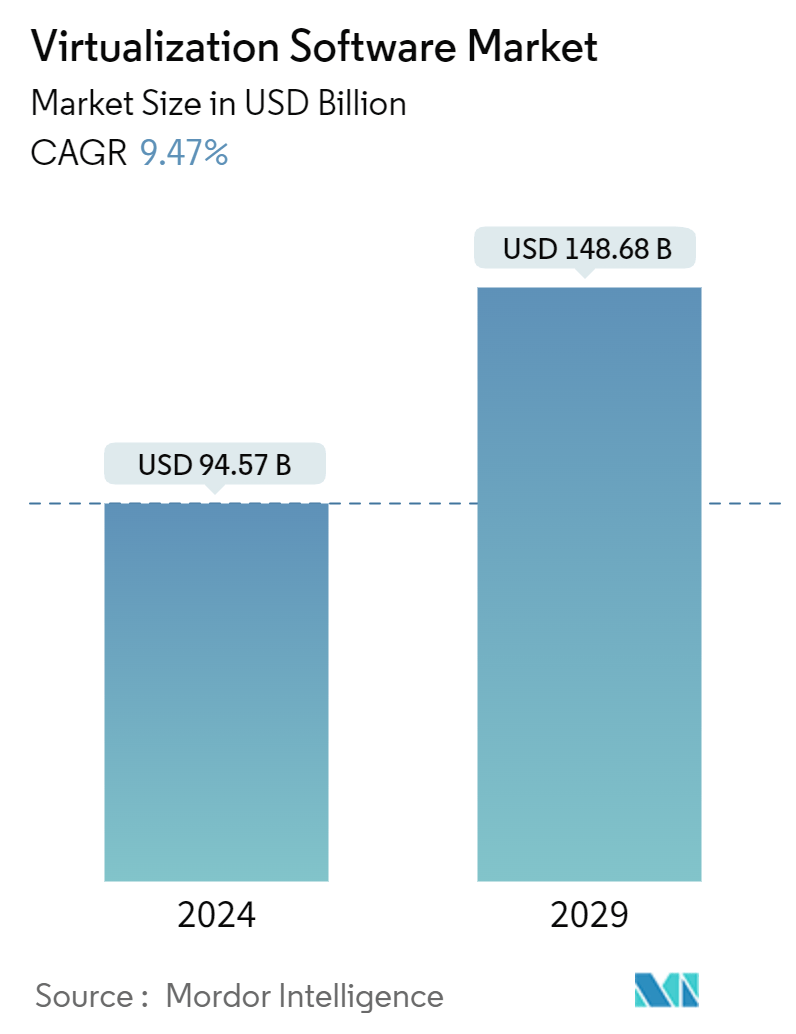
| Study Period | 2019 - 2029 |
| Market Size (2024) | USD 94.57 Billion |
| Market Size (2029) | USD 148.68 Billion |
| CAGR (2024 - 2029) | 9.47 % |
| Fastest Growing Market | Asia Pacific |
| Largest Market | North America |
Major Players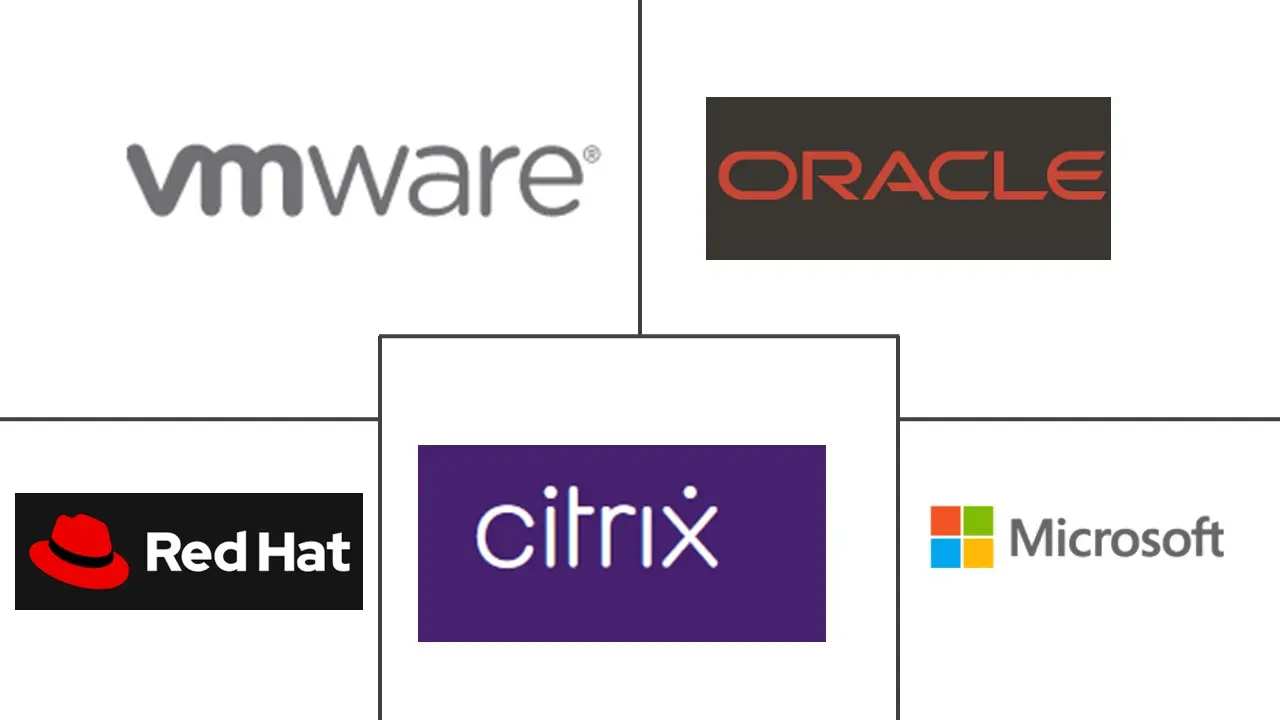
*Disclaimer: Major Players sorted in no particular order |
Virtualization Software Market Analysis
The Virtualization Software Market size is estimated at USD 94.57 billion in 2024, and is expected to reach USD 148.68 billion by 2029, growing at a CAGR of 9.47% during the forecast period (2024-2029).
The virtualization software market is a pivotal component of modern IT infrastructure, enabling businesses to optimize resource utilization, streamline management processes, and reduce operational costs. Virtualization software abstracts hardware systems, allowing multiple virtual environments to operate on a single physical machine. This decoupling of hardware from software facilitates the creation of virtual machines (VMs), which emulate physical computers, enhancing flexibility for applications such as server virtualization, cloud computing, and disaster recovery. As organizations increasingly adopt data center virtualization and cloud-based services to meet rising computational demands, the virtualization software market continues to expand.
- Efficiency through Virtualization: Virtualization technologies offer significant efficiency improvements, enabling IT departments to deploy resources quickly and scale infrastructure as needed. Businesses benefit from centralized management and enhanced virtualization security. Open-source virtualization software provides cost-effective solutions, while proprietary platforms offer comprehensive features and dedicated support. However, successful implementation of virtualization often requires specialized expertise for setup and configuration, particularly in complex environments.
- Key Industry Players: Major players such as VMware, Microsoft, Citrix Systems, and Oracle are leading innovation in this field. These companies are focused on developing virtualization platforms that support server virtualization, network virtualization, desktop virtualization, and cloud-native virtualization. To stay competitive, these market leaders invest in enhancing hypervisor technology, improving automation, and integrating robust security features.
IT Infrastructure Optimization through Virtualization
- Cost Reduction: Virtualization helps businesses reduce operational expenses by minimizing the need for additional hardware. With server virtualization, multiple virtual machines run on a single server, optimizing hardware utilization and cutting costs associated with purchasing and maintaining physical servers.
- Hardware Savings: Traditional IT environments require separate physical servers for different operating systems, leading to hardware underutilization. By virtualizing these systems, companies achieve higher server utilization rates, reducing the overall number of physical machines required. This contributes to reduced capital expenditures on hardware and lower energy consumption.
- Scalability: Virtualization software enables rapid scaling of IT infrastructure. Businesses can quickly create, clone, or migrate virtual machines with minimal downtime, allowing them to respond to fluctuating demand in cloud environments or high-performance computing scenarios.
- Energy Efficiency: Consolidating physical servers leads to fewer energy requirements for power and cooling, enhancing the energy efficiency of data centers. This not only lowers operational costs but also supports corporate sustainability efforts by reducing the organization’s carbon footprint.
Streamlining IT Operations with Virtualization
Virtualization technology dramatically simplifies IT management by allowing teams to centrally manage virtual environments. The ability to deploy virtual machines quickly and troubleshoot issues through a single platform enhances operational efficiency.
- Centralized Management: Virtual machine management is simplified through centralized control offered by virtualization platforms. IT administrators can deploy, update, and manage multiple virtual environments from a single interface, reducing complexity and minimizing the time spent on maintenance.
- Disaster Recovery: Virtualization solutions enhance disaster recovery strategies. Virtual machines can be easily backed up and restored, significantly improving recovery times in case of system failure. Moreover, many virtualization platforms incorporate disaster recovery tools, reducing reliance on third-party solutions.
- Enhanced Security: Virtualization enables the isolation of virtual machines, reducing the risk of security breaches. With virtualization security features like role-based access control, encryption, and secure migration, businesses can safeguard sensitive data and limit the impact of potential attacks.
Virtualization Software Market Trends
PC/ Desktop Virtualization is Expected to hold Major Market share
- As the demand for scalable and efficient IT solutions grows, the virtualization software market is expanding rapidly. Virtualization technology, which enables the creation of virtual versions of hardware and storage devices, boosts resource utilization while cutting costs. Cloud computing, data center virtualization, and advancements in hypervisor technology are key drivers of this market. Several notable trends are shaping the future of virtualization software.
- Remote Work Boosting VDI Adoption: The shift to remote work has driven adoption of virtual desktop infrastructure (VDI), which enables businesses to securely deploy desktop environments from central servers. This ensures seamless performance regardless of the employee’s location while reducing hardware costs.
- Application Virtualization Growth: As companies look to minimize compatibility issues and secure legacy systems, application virtualization is gaining traction. This technology allows applications to run independently from the underlying operating system, reducing risks and enhancing compatibility.
- Open-Source Software Expansion: Cost-effective open-source virtualization platforms such as KVM and Xen are gaining popularity, particularly among SMEs. These platforms provide powerful virtual machine management tools, helping businesses optimize their systems without incurring high licensing costs.
- Focus on Security: With the rise of cloud virtualization and hybrid IT setups, securing virtual environments has become a priority. The need to protect virtual machines and hypervisor layers drives demand for advanced security solutions, ensuring PC/desktop virtualization remains a dominant force in the market.
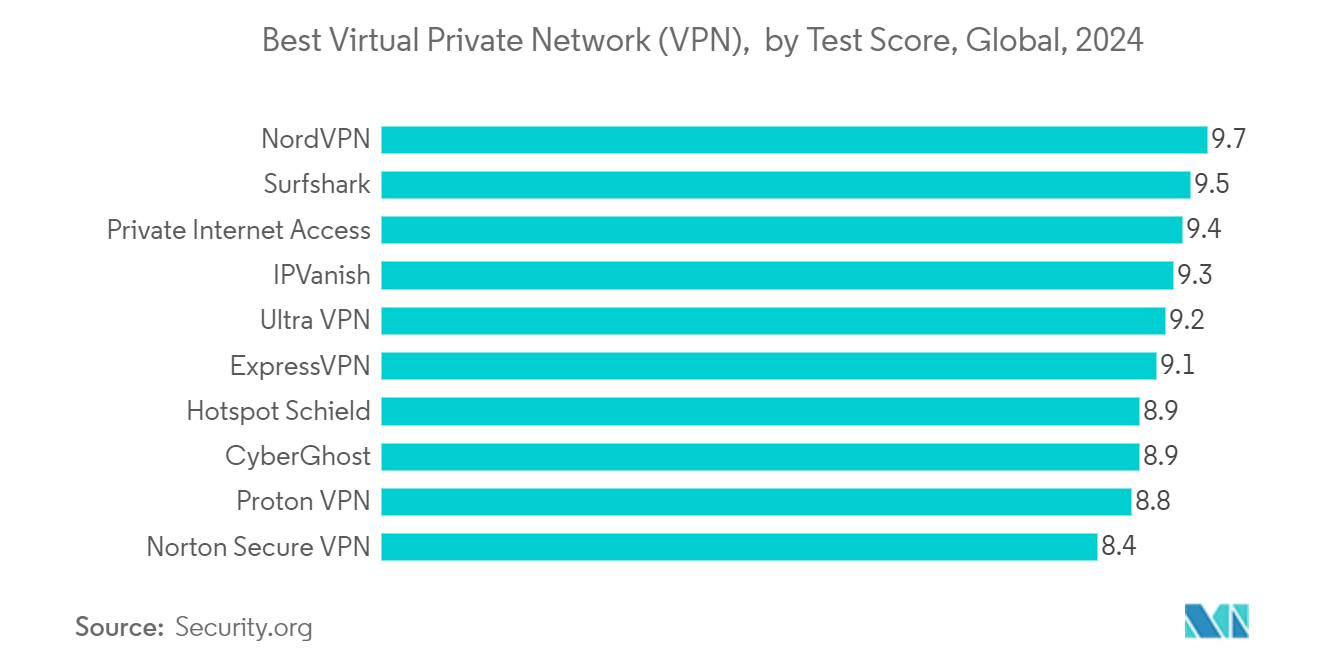
Asia Pacific is Expected to Register the Largest Market
- The Asia-Pacific region is expected to dominate the virtualization software market due to rapid industrialization, growing IT infrastructure investments, and the increasing adoption of cloud computing. Countries such as China, India, and Japan are spearheading this digital transformation, especially within industries like telecommunications and BFSI (Banking, Financial Services, and Insurance).
- Cloud Virtualization Growth: Businesses in the region are rapidly adopting cloud virtualization to enhance resource efficiency and cut IT costs. As companies shift from traditional hardware to virtualized environments, the demand for cloud services is driving robust market expansion.
- Open-Source Solutions for SMEs: Small and medium-sized enterprises (SMEs) are increasingly adopting open-source virtualization software due to its cost-efficiency and flexibility. This trend is bolstered by government initiatives to promote digital infrastructure in countries like India, leading to a higher demand for affordable, scalable virtualization solutions.
- Containerization Trends: The region is also witnessing a rise in containerization technologies, which offer more efficiency for cloud-native applications compared to traditional virtualization. This shift supports the growth of hybrid and multi-cloud environments, blending the benefits of both virtualization and containerization.
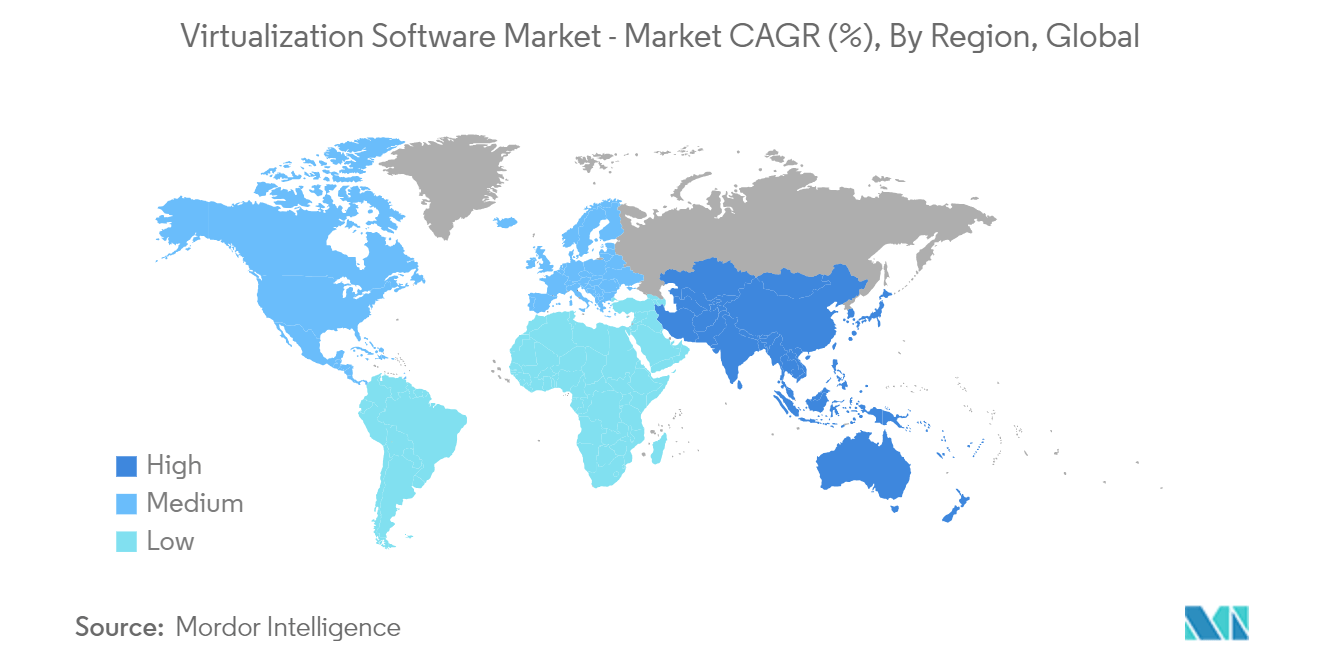
Virtualization Software Industry Overview
The virtualization software market is highly fragmented, with major corporations and niche players competing for market share. Companies like VMware, Microsoft, Oracle, and Citrix dominate the global landscape by offering comprehensive virtualization solutions across various sectors, including server virtualization, network virtualization, and desktop virtualization.
Key Industry Leaders: VMware remains a market leader with a wide range of solutions for data center virtualization. Microsoft’s Hyper-V platform leverages the company’s strong position in cloud services, while Oracle and Citrix focus on providing advanced, integrated virtualization solutions.
Emerging Trends for Future Growth: As trends like cloud-native virtualization and containerization gain traction, the market is shifting toward more agile and scalable solutions. Companies must invest in cloud integration, enhanced security, and support for multi-cloud environments to stay competitive. Emerging technologies like edge computing will also play a crucial role in shaping the future of this dynamic industry.
Virtualization Software Market Leaders
-
VMware Inc
-
Citrix Systems Inc.
-
Oracle Corporation
-
Microsoft Corporation
-
Red Hat Inc. (IBM Corporation)
*Disclaimer: Major Players sorted in no particular order
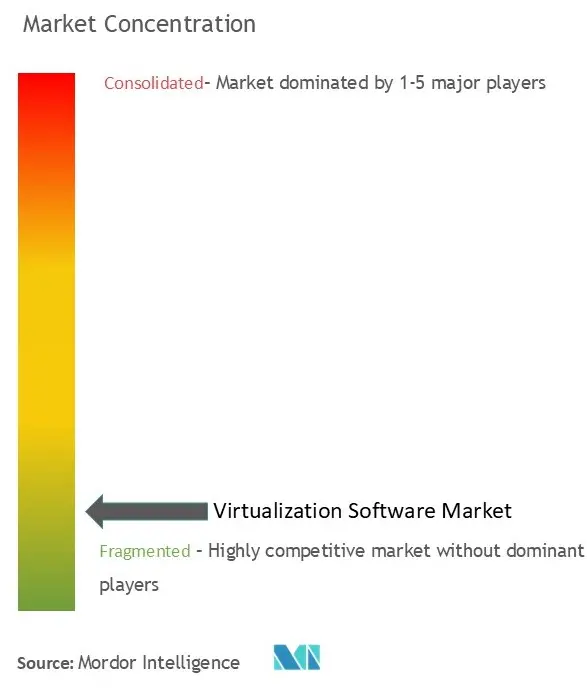
Virtualization Software Market News
- June 2024 - Hewlett Packard Enterprise has expanded its hybrid cloud offerings by introducing HPE virtualization capabilities for HPE Private Cloud. This new feature integrates an open-source kernel-based virtual machine (KVM) with HPE’s advanced cluster orchestration software, ensuring the high performance and availability that demanding enterprise workloads require. The virtualization clusters are overseen by a cloud-based control plane, eliminating the need for on-premises management and conserving valuable resources.
- April 2024 - Denodo, a frontrunner in data management, has unveiled a fresh integration of its Denodo Platform with Google Cloud’s Vertex AI, marking a significant milestone in their partnership. Leveraging data virtualization, the Denodo Platform collaborates with Google Cloud to enable their shared clientele to pioneer innovative solutions.
Virtualization Software Market Report - Table of Contents
1. INTRODUCTION
- 1.1 Study Assumptions and Market Definition
- 1.2 Scope of the Study
2. RESEARCH METHODOLOGY
3. EXECUTIVE SUMMARY
4. MARKET INSIGHTS
- 4.1 Market Overview
-
4.2 Industry Attractiveness - Porter's Five Forces Analysis
- 4.2.1 Bargaining Power of Suppliers
- 4.2.2 Bargaining Power of Consumers
- 4.2.3 Threat of New Entrants
- 4.2.4 Intensity of Competitive Rivalry
- 4.2.5 Threat of Substitutes
- 4.3 Assessment of Impact Of Covid-19 on the Industry
5. MARKET DYNAMICS
-
5.1 Market Drivers
- 5.1.1 Cost Reductions due to Reduced Hardware Spending
- 5.1.2 Improved IT Efficiency due to Virtualization
-
5.2 Market Challenges
- 5.2.1 Complexity in Setting up a Virtual Environment
6. MARKET SEGMENTATION
-
6.1 By Platform
- 6.1.1 PC Virtualization
- 6.1.2 Mobile Virtualization
-
6.2 By Type
- 6.2.1 Application Virtualization
- 6.2.2 Network Virtualization
- 6.2.3 Hardware Virtualization
- 6.2.4 Other Types
-
6.3 By Geography***
- 6.3.1 North America
- 6.3.2 Europe
- 6.3.3 Asia
- 6.3.4 Australia and New Zealand
- 6.3.5 Latin America
- 6.3.6 Middle East and Africa
7. COMPETITIVE LANDSCAPE
-
7.1 Company Profiles*
- 7.1.1 VMware Inc
- 7.1.2 Citrix Systems Inc.
- 7.1.3 Oracle Corporation
- 7.1.4 Microsoft Corporation
- 7.1.5 Red Hat Inc. (IBM Corporation)
- 7.1.6 Amazon Inc.
- 7.1.7 Google LLC.
- 7.1.8 NComupting Co. Ltd.
- 7.1.9 Parallels International GmbH
- 7.1.10 Huawei Technologies Co. Ltd.
- 7.1.11 Datadog, Inc.
- 7.1.12 Nutanix Inc.
- 7.1.13 TenAsys Corporation
- 7.1.14 Lynx Software Technologies
8. INVESTMENT ANALYSIS
9. MARKET OPPORTUNITIES AND FUTURE TRENDS
** Subject To AvailablityVirtualization Software Industry Segmentation
Virtualization Software, also called a Hypervisor, allows two or more operating systems (OSs) to run on a single host machine or server. The software can run on a machine without OS (Type 1) or on top of an OS (Type 2). It allows the virtualization of components, like hardware, OS, network, or storage. The study covers the market based on the platform on which the software OS is hosted, and the type of virtualization software available across the globe.
The virtualization software market is segmented by platform (PC virtualization and mobile virtualization), by type (application virtualization, network virtualization, and hardware virtualization), and by geography (North America, Europe, Asia Pacific, Latin America, and Middle East and Africa). The report offers market forecasts and size in value (USD) for all the above segments.
| By Platform | PC Virtualization |
| Mobile Virtualization | |
| By Type | Application Virtualization |
| Network Virtualization | |
| Hardware Virtualization | |
| Other Types | |
| By Geography*** | North America |
| Europe | |
| Asia | |
| Australia and New Zealand | |
| Latin America | |
| Middle East and Africa |
Virtualization Software Market Research FAQs
How big is the Virtualization Software Market?
The Virtualization Software Market size is expected to reach USD 94.57 billion in 2024 and grow at a CAGR of 9.47% to reach USD 148.68 billion by 2029.
What is the current Virtualization Software Market size?
In 2024, the Virtualization Software Market size is expected to reach USD 94.57 billion.
Who are the key players in Virtualization Software Market?
VMware Inc, Citrix Systems Inc., Oracle Corporation, Microsoft Corporation and Red Hat Inc. (IBM Corporation) are the major companies operating in the Virtualization Software Market.
Which is the fastest growing region in Virtualization Software Market?
Asia Pacific is estimated to grow at the highest CAGR over the forecast period (2024-2029).
Which region has the biggest share in Virtualization Software Market?
In 2024, the North America accounts for the largest market share in Virtualization Software Market.
What years does this Virtualization Software Market cover, and what was the market size in 2023?
In 2023, the Virtualization Software Market size was estimated at USD 85.61 billion. The report covers the Virtualization Software Market historical market size for years: 2019, 2020, 2021, 2022 and 2023. The report also forecasts the Virtualization Software Market size for years: 2024, 2025, 2026, 2027, 2028 and 2029.
Virtualization Software Industry Report
Virtualization Software Market Research
Our industry research on the virtualization software market provides comprehensive insights into key trends, competitive dynamics, and technological advancements shaping this sector. The report covers essential aspects such as hypervisor technology, server virtualization, and virtualization security, enabling businesses to make informed decisions. It highlights the growing adoption of cloud virtualization and virtual desktop infrastructure (VDI), with in-depth analysis on how open-source virtualization software is transforming IT strategies. Stakeholders can leverage this data to better understand emerging trends like containerization, network virtualization, and the rise of hybrid cloud solutions.
The virtualization software market report is an invaluable resource for decision-makers, offering detailed industry forecasts, market growth insights, and strategic recommendations. The report pdf delivers clear, data-driven analysis, helping businesses optimize their IT infrastructure through virtualization platforms while navigating challenges in scalability, security, and cost reduction. Whether you are exploring new market opportunities or seeking to enhance operational efficiency, this report offers the industry expertise needed to stay competitive in an evolving landscape.



